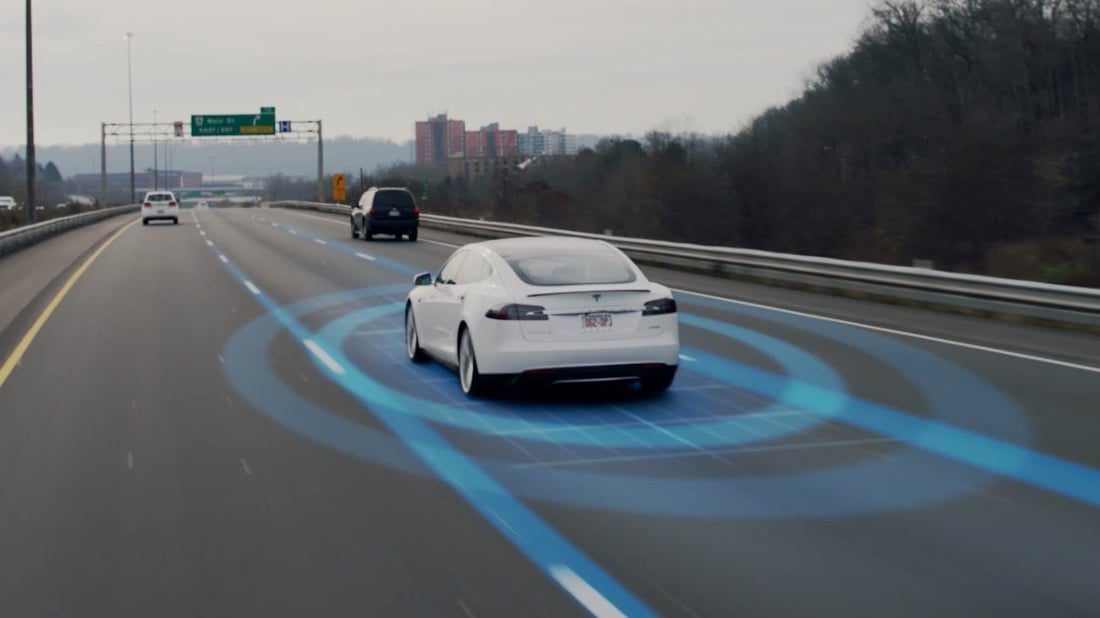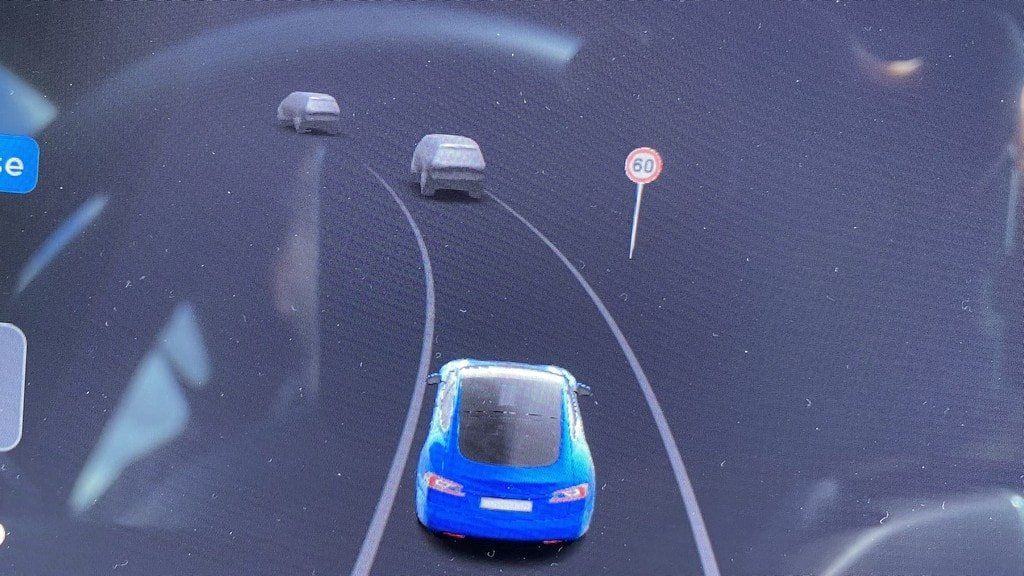The combination of different driver assistance systems is also called autopilot by Tesla. Since the system is constantly being further developed, there are now several versions. The difference is the autopilot hardware installed in the Tesla vehicle, the activated software options and the resulting possible range of functions. Starting in October 2014, all Tesla vehicles were equipped with autopilot hardware. When buying the vehicle, you can decide if you want to activate the autopilot software options for an additional charge. Of course, such an option can also be purchased later at any time for an additional charge.
Durable 12"x9" sized aluminum sign
Hangs easily anywhere
Will last for years
Shop for more Tesla Accessories here!
The oldest autopilot generation is the “Autopilot Hardware 1”, also called AP1 or HW1 (Hardware1) for short. Later came AP2, then AP2.5 and the current generation is AP3. But officially it is only called “FSD Computer”. In internet forums it is also called AP3 or HW3 for simplicity.
Comparison table of the Tesla Autopilot. Difference between AP1 vs AP2 and AP3
The following table shows an overview of the differences in functionality of all Tesla Autopilot versions. The same generation is color-coded in each case (AP2.5 was just an improvement of AP2):
What can vehicles without Tesla Autopilot function do?
This concerns:
- Vehicles manufactured before October 2014, when no autopilot hardware was installed.
- Vehicles manufactured between October 2014 and October 2016 without activated autopilot option
- Vehicles manufactured from October 2016 until approximately mid-April 2019 without the “enhanced autopilot” (EAP) option enabled.
These vehicles have only a simple cruise control. The cruise control can maintain the set speed. However, it does NOT control the distance to the vehicle in front. This is identical regardless of the autopilot hardware installed and therefore affects old and new vehicles alike. However, the autopilot safety functions such as automatic emergency braking, warning of front collisions and side impacts will be standard equipment in vehicles from October 2014, despite the absence of an autopilot.
The “Autopilot” (2019) option is included free of charge for vehicles from around mid-April 2019. However, the range of functions has been reduced compared to the previous “enhanced autopilot” (EAP) option, as some functions have been moved to the chargeable “full self driving” (FSD) option. The feature difference between Tesla Autopilot and FSD is likely to grow in the future. More about FSD here.
“Navigate on Autopilot” (NoA), “Autopark” and “Summon” features
Those features do NOT work for the three vehicle variants without autopilot listed above.
Tesla Autopilot Hardware differences between AP1 vs AP2 vs AP3
Autopilot 1 (AP1/HW1)
AP1 is the first generation of the Tesla Autopilot. The hardware for AP1 was installed in the Model S and X vehicles from October 2014 to October 2016. It was originally not developed by Tesla, but by the company MobilEye under the system EyeQ3. The hardware is based on a black and white front camera, ultrasonic sensors and a radar in the front. Due to the lack of all-round visibility, there is inevitably no 360° view with cameras. Fully autonomous driving will never be possible with this hardware. The AP1 is so far the only autopilot in Tesla vehicles to have traffic sign recognition. A subsequent activation of this autopilot option in a vehicle with AP1 hardware costs 3100 EUR.
Vehicles with AP1 are still provided with software updates. However, the assistance system will not change much, since Tesla is only developing the autopilot functions with the newer hardware. Model 3 with AP1 hardware does not exist because Model 3 will be built in 2017.
Autopilot 2 (AP2/HW2)
AP2 is the second generation autopilot hardware. The hardware for AP2 has been installed in the Model S and X vehicles from October 2016 to approximately August 2017. The hardware was developed by the company Nvidia. Compared to the AP1, the AP2’s computing unit has 40 times the computing power of its predecessor.
This hardware version of the autopilot has 8 cameras with RCCC color filter to display a 360-degree view around the vehicle. Improved ultrasonic sensors and a radar in the front supplement the information from the camera images. Model 3 vehicles with AP2 hardware do not exist, as Tesla had started to install only AP2.5 hardware in its new cars before the production start of Model 3. So, all Model 3 vehicles have at least AP2.5.
Tesla develops the software for the AP2 hardware itself. However, the departure from the AP1 supplier MobilEye significantly slowed the further development of the autopilot in 2016 and 2017. Even basic functions had to be completely reprogrammed for the new hardware which led to a massive delay in further development.
Autopilot 2.5 (AP2.5/HW2.5)
This is the revised version of AP2, which is abbreviated to AP2.5. The hardware for AP2.5 will be installed in the Model S, X and Model 3 vehicles from about August 2017 until about April 2019. The hardware was also developed by the company Nvidia and is a further development based on AP2. The difference to AP2 is a little more computer power, additional redundant cabling, a different front radar and better cameras. AP2.5 is not a completely new design, but an optimization of AP2. The AP2.5 hardware uses cameras with RCCB. 8 filters, while AP2 still uses cameras with RCCC filters.
Autopilot 3 (FSD Computer/AP3/HW3)
The FSD computer differs from the AP2.5 only in its computing unit. Cabling and cameras are identical. The computing unit was developed by Tesla itself with specially designed AI processors on a completely new basis. The performance of the AP2.5 could process about 110 camera frames per second. With the FSD computer processing unit, it seems to be possible to process 2300 frames per second. That is factor 21 better! Many technical details here in the Autonomy Day Video from April 2019.
As Elon Musk explained on “Tesla Autonomy Day”, the FSD Computer Processors in Model S and Model X were already installed since March 2019. Since mid-April 2019, only FSD computers are used in all Model3. An exception seems to be the Model 3 with Standard Range Plus. Only vehicles for which FSD has been ordered from the beginning were most likely equipped with the FSD Computer ex factory. A good summary of the Autonomy Day here at Mario Herger.
Tesla Autopilot Software Options
Autopilot (2014)
Available as a paid software option for Model S and Model X with built-in autopilot hardware AP1. In addition to the lane keeping assistant, automatic parking and calling up are also available.
Improved Autopilot Functionality (EAP)
Based on the autopilot hardware from AP2 or higher, the EAP option is offered as a paid software option for appropriately equipped vehicles. Originally, EAP was only available for vehicles between 2016 and April 2019. However, a special offer in autumn 2019 made EAP temporarily available again. This allows customers to activate features such as automatic lane change without purchasing the more expensive FSD package.
Free Autopilot (from 2019)
The free autopilot based on AP2.5 and AP3 hardware was introduced for new cars in March 2019. As a result, previously paid options such as the lane departure warning system have been transferred to the base.
Full potential for autonomous driving (FSD)
For vehicles equipped with Autopilot Hardware AP2 or higher, this paid option can be activated. Buyers of the software option “Full Self-Driving” (FSD) receive the “FSD Computer” hardware free of charge. More about this in the article about the Autopilot Upgrade.
How can I tell which Autopilot hardware is installed in my Tesla?
In the vehicle settings under “Software”, “Additional vehicle information” is displayed. There you will also find a note about the installed autopilot hardware.
Camera differences
AP2 has cameras with RCCC filters, while AP2.5 and Ap3 are equipped with RCCB cameras. The Youtuber “daerik” has replaced the old flasher cameras with the latest generation on its Model S (cost per camera $110). The replacement is pure comfort, for the autopilot functionality the new cameras are not necessary. The differences between the cameras can be clearly seen on the pictures of this video.
When will AP4 arrive?
According to this report from Electrek, the future chip for the AP4 computer is expected to go into mass production in Q4 / 2021. With the 7 nanometer class, the chip should further reduce the power consumption of the computer. The new computer is expected to be available in vehicles from early 2022.
More details about the Tesla Autopilot and AP1 vs AP2 and AP3
- Many technical details on Wikipedia.
- Description of the current autopilot version at Tesla.
- More details about FSD.
Check your VIN number:







